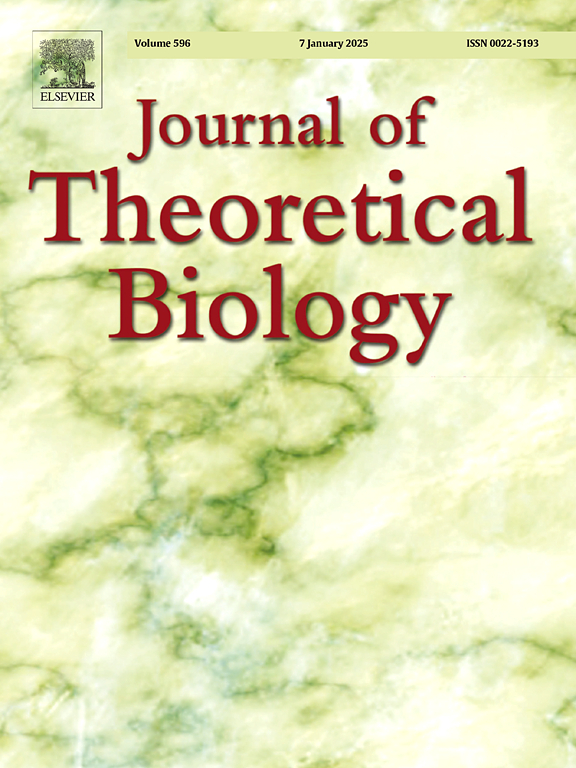在个体动物运动中架起短距离和远距离分散的桥梁。
IF 2
4区 数学
Q2 BIOLOGY
引用次数: 0
摘要
随机漫步(RW)在个体层面上为动物的运动提供了一个有用的建模框架。如果RW是不相关和无偏的,因此运动方向是完全随机的,那么分散的特征是步长概率分布的统计特性,或分散核。个体是否表现出短期或长距离的分散,可以通过步长分布的端尾渐近衰减率来区分。如果衰减是指数型的或更快的,称为细尾,那么步长变化是有限的——就像在布朗运动中发生的那样。另一方面,逆幂律步长分布具有较慢衰减的重端尾,导致无限步长方差,这是lsamvy行走的标志。在动物个体运动的理论研究中,人们采用了各种方法来联系这些扩散机制,但它们往往是临时的。我们提供了一种更稳健的方法,通过确保生存概率,即出现超过某一阈值的步骤的概率在两个分布中是相同的。此外,通过调整概率来最小化这些分布之间的差异,从而使分散核标准化。假设运动路径的生存概率相同,通常采用细尾和重尾步长分布,我们形成了动物在不同空间维度上的短距离和长距离传播关系。我们还展示了如何将我们的发现应用于不同的生态环境,将扩散核与边界效应和时空种群动态的理论模型联系起来。此外,我们表明,这些分散核之间的关系可以极大地影响各种生态情景的结果。本文章由计算机程序翻译,如有差异,请以英文原文为准。

Bridging short- and long-distance dispersal in individual animal movement
Random walks (RW) provide a useful modelling framework for the movement of animals at an individual level. If the RW is uncorrelated and unbiased such that the direction of movement is completely random, the dispersal is characterised by the statistical properties of the probability distribution of step lengths, or the dispersal kernel. Whether an individual exhibits short- or long-distance dispersal can be distinguished by the rate of asymptotic decay in the end-tail of the distribution of step-lengths. If the decay is exponential or faster, referred to as a thin-tail, then the step length variance is finite – as occurs in Brownian motion. On the other hand, inverse power-law step length distributions have a heavy end-tail with slower decay, resulting in an infinite step length variance, which is the hallmark of a Lévy walk. In theoretical studies of individual animal movement, various approaches have been employed to connect these dispersal mechanisms, yet they are often ad hoc. We provide a more robust method by ensuring that the survival probability, that is the probability of occurrence of steps longer than a certain threshold is the same for both distributions. Furthermore, the dispersal kernels are then standardised by adjusting the probability to minimise disparities between these distributions. By assuming the same survival probability for movement paths with commonly used thin- and heavy-tailed step length distributions, we form a relationship between the short- and long-distance dispersal of animals in different spatial dimensions. We also demonstrate how our findings can be applied in different ecological contexts, to relate dispersal kernels within theoretical models for boundary effects and spatio-temporal population dynamics. Moreover, we show that the relationship between these dispersal kernels can drastically affect the outcomes across various ecological scenarios.
求助全文
通过发布文献求助,成功后即可免费获取论文全文。
去求助
来源期刊
CiteScore
4.20
自引率
5.00%
发文量
218
审稿时长
51 days
期刊介绍:
The Journal of Theoretical Biology is the leading forum for theoretical perspectives that give insight into biological processes. It covers a very wide range of topics and is of interest to biologists in many areas of research, including:
• Brain and Neuroscience
• Cancer Growth and Treatment
• Cell Biology
• Developmental Biology
• Ecology
• Evolution
• Immunology,
• Infectious and non-infectious Diseases,
• Mathematical, Computational, Biophysical and Statistical Modeling
• Microbiology, Molecular Biology, and Biochemistry
• Networks and Complex Systems
• Physiology
• Pharmacodynamics
• Animal Behavior and Game Theory
Acceptable papers are those that bear significant importance on the biology per se being presented, and not on the mathematical analysis. Papers that include some data or experimental material bearing on theory will be considered, including those that contain comparative study, statistical data analysis, mathematical proof, computer simulations, experiments, field observations, or even philosophical arguments, which are all methods to support or reject theoretical ideas. However, there should be a concerted effort to make papers intelligible to biologists in the chosen field.

 求助内容:
求助内容: 应助结果提醒方式:
应助结果提醒方式:


